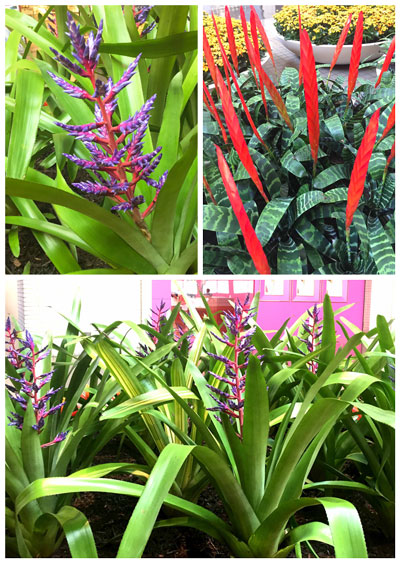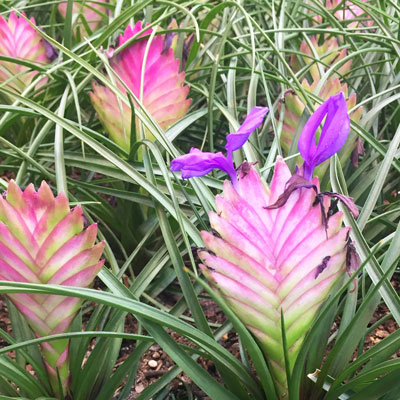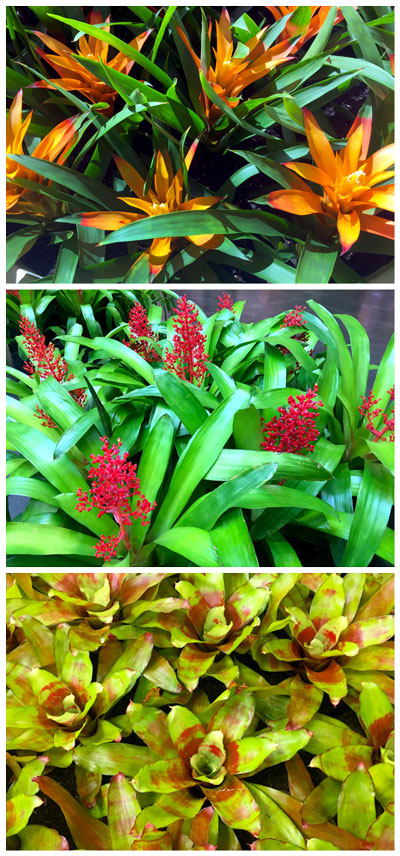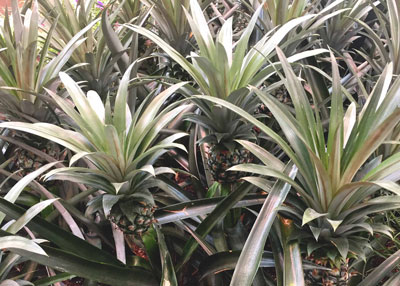Bedazzling Bromeliads
My wife’s iPhone needed a small repair. We’d been running some errands, so she set an appointment at the Apple Store at NorthPark Center in Dallas. That involved a bit of a wait. As did the visit to the ladies’ shoe store. As did the hunt for the skirt she’d seen online.

Photo: This glorious massed “planting” of a compact bromeliad is right outside the Apple Store at NorthPark. It called my name and told me I needed to walk to see more.
Tired of the benches and people-watching, I took time to admire the interiorscaping in the planters inside the mall’s corridors. NorthPark has featured glorious plants in its aisles since the days of my friend Steve Klandich clear back in the 70s. I share with you here photos I took with my own iPhone while we waited for the repairs.

Photos: Showy floral spikes of bromeliads last for months of brilliant color on end.
Before we go any farther, let me admit to you that (1) I love bromeliads, but (2) I find the thousands of hybrids confusing and hard to tell apart. The plants at NorthPark don’t have any labels. I recognized some of them, but many I did not. I’m offering them to you here more in the spirit of getting you interested in the whole group of bromeliads in general rather than in recommending specific types.
That said, I’ve been collecting many types of neoregelias for the past several years. I found a couple of really good sources via eBay of all places, and I have perhaps 200 cultivars that I mass in our landscape each summer. I find the trailing rhizomatous types especially appealing. I grow them in large patio baskets, also in shallow pots and bowls. Given bright light and a year or two to become established, they become very colorful. Of course, like almost all bromeliads, they require protection from frosts and freezes.

Photo: Small type of Tillandsia is cheerful while blooming. It’s a close relative of our familiar Spanish moss.
Bromeliads in nature are either terrestrial or epiphytic, meaning that they either grow in soil or suspended from tree trunks. Most of the large, colorful types are epiphytes in Tropical Central and South America. Many of the terrestrial types are xeriphytic, meaning that they grow in arid areas, usually in gravelly, well-draining soils.

Photos: It’s hard to imagine more colorful tropical plants than bromeliads!
How bromeliad species grow in nature gives you a giant head start on how you should grow them as houseplants and out on the patio. However, even the epiphytic types can be grown in pots if you choose a very porous, perfectly draining potting soil. Keep them moist at all times and nourished with a complete-and-balanced, water-soluble plant food every couple of times that you water them.

Photo: The best-known bromeliads of them all, pineapples are easily grown and can even be brought into flower and fruit.
Special details about growing pineapples…
NorthPark even has several of their container beds filled with fruiting pineapples. They, too, are terrestrial bromeliads, and if you’ve never seen them growing in nature, you might enjoy seeing them at NorthPark.
You can actually grow your own pineapple and bring it into fruit. I have the step-by-step instructions in the FAQ pages of my website. Click here to see how.
